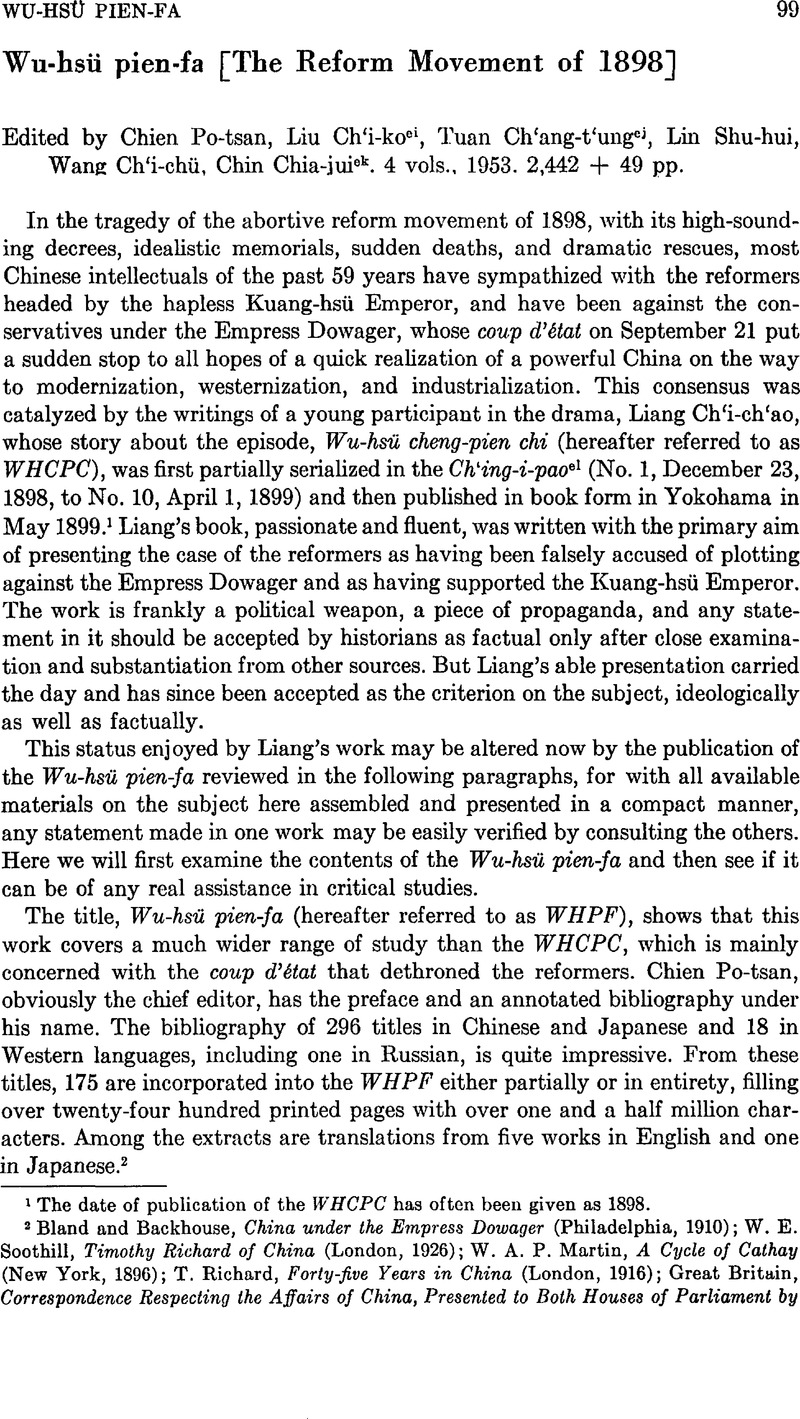Published online by Cambridge University Press: 23 March 2011

1 The date of publication of the WHCPC has often been given as 1898.
2 Bland, and Backhouse, , China under the Empress Dowager (Philadelphia, 1910)Google Scholar; Soothill, W. E., Timothy Richard of China (London, 1926)Google Scholar; Martin, W. A. P., A Cycle of Cathay (New York, 1896)Google Scholar; Richard, T., Forty-five Years in China (London, 1916)Google Scholar; Britain, Great, Correspondence Respecting the Affairs of China, Presented to Both Houses of Parliament by Command of Her Majesty (03, 1899)Google Scholar; and Gonsuke, Hayashifd, Waga shichijūnen wo katarufe (Tokyo, 1939).Google Scholar
3 There is also a manuscript copy of Chang Chih-tung's collected public papers, from which only a brief passage is cited (IV, 555). The Hoover Library has a microfilm which is said by K'ang Yu-wei's daughter to include all his unpublished works.
4 Public Record Office, London, F.O. 17/1718, photostatic copy. The author of the memorandum, F. S. A. Bourne, also had a paper entitled “Possible and Impossible Reforms,” published in JNCBRAS, XXXIII, No. 1 (1899–1900).Google Scholar
5 Such as the collected works of T'ang Ts'ai-ch'ang (IV, 602; III, 95–106) and Tseng Lien” (IV, 606; II, 489–503), and the annalistic biography of Liang Ch'i-ch'ao by Yang Fu-lifg (IV, 171–175, 616).
6 The K'ang Nan-hai hsien-sheng mo-chi was originally published in 1931 in four fascicles, one of which contains five lithographically reproduced letters from the original copies written in 1898 by K'ang Yu-wei and Liang Ch'i-ch'ao to Timothy Richard. Only two of K'ang's letters, however, were written in his own hand. Two more were evidently written by others using K'ang's name.
7 In another part of the WHPF (I, 371) an edict referred to as “No. 229” is actually found to be No. 231 (II, 93). The discrepancy may be the result of the insertion of Nos. 228 and 229 at a much later stage in the compilation and the consequent changes in the numerical order.
8 Op. cit., Note 2; WHPF, III, 524Google Scholar. The following edict as given by Bourne is different from the Chinese text in the K'ang Nan-hai mo-chi. The brackets enclose material inserted in the letter: “I, the Emperor, think that in times as dangerous and difficult as the present, China can only be saved by the adoption of Western methods, and that Western methods can only be adopted if the conservative staunch old high officials be dismissed [and we employ intelligent and brave young talents], but in this the Dowager Empress does not agree with me.
“I have represented this to her many times, but she only becomes the more angry. At present my seat is not secure. I hope that you and others [names of four men] of the same way of thinking will quickly and secretly contrive a means of assistance. I am very anxious and ill at ease.”
9 See K'ang Nan-hai mo-chi. Vol. III. The text of the edicts is omitted in WHPF (I, 415).
10 Wu Hsiang-hsiang, “Weng T'ung-ho K'ang Yu-wei kuan-hsi k'ao-shih”fh, in Hsüeh-shu chi-k'an, IV, No. 2 (1955), 97–108Google Scholar; idem, “Wu-hsü cheng-pien yü cheng-pien chih kuo-chi pei-ching”, ibid., IV, No. 3 (1956), 74–83.